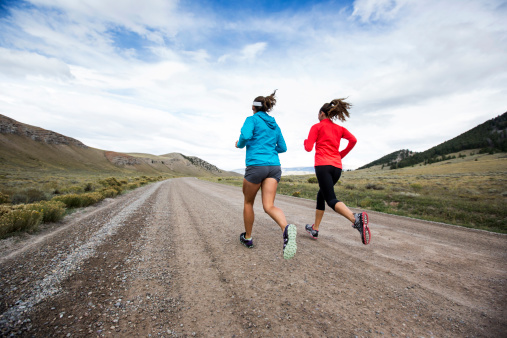
You already know that staying fit is good for you. Exercise lowers the risk of heart disease, may help prevent certain types of cancer, lowers your risk of osteoporosis, prevents weight-gain and type 2 diabetes, helps you sleep better, and improves muscle and lung function. It can help lower anxiety and prevent depression, too. Working out also releases endorphins, our bodies’ stress-fighters, leaving us feeling at ease, research suggests. In other words, working out can actually feel good—and even be fun.
Not sold? You’re not alone. Less than five percent of adults do at least 30 minutes of physical activity daily, according to the President’s Council on Fitness, Sports & Nutrition. While we’re supposed to be engaging in 150 minutes of cardio per week, plus two days’ worth of strength training targeting all the major muscle groups, only one-third of us actually do this. But working out doesn’t have to be a drag. Here are four ways to kick start (and get a kick out of) your fitness routine.
1. Crank up the tunes.
If you’re power-walking, running, or lifting weights, music can improve performance and even make you think the strenuous activity is easier than you otherwise might. Music helps you coordinate your workout, says Fabio Comana, a faculty instructor at the National Academy of Sports Medicine. For example, lyrics can reinforce aspects of a technique when they feature words like “punch,” “cut,” or “push.”
The beat of your music can also affect how you synchronize your workout. Comana suggests the tempo of the music you listen to reflect the type of workout you’re doing. Look up the beats per minute (BPM) on any song here or listen and tap along to the beat using a BPM calculator. Here are some basic guidelines on which speeds to look for.
While music can make our workouts more fun, Comana warns against becoming too dependent on music—or TV—to distract from the exercise. “Sustainable behavior is connected to the experience and if music serves only to distract and tolerate, then no sustainable behavior is established,” he says. “In this case, if that music is removed, there is no reason to exercise.”
2. Head outside.
You probably don’t need science to confirm that a jog through the woods is more enjoyable than pounding away on a treadmill, but exercising outdoors decreases feelings of tension, anger, and depression, while increasing engagement and helping participants feel more energized, research suggests. “Being outside enriches your experience,” says Ellen Miller, the only American woman to have summited both sides of Mt. Everest and Outdoor Fitness Coach at the Vail Vitality Center and Vail Athletic Club in Vail, Colorado.
But you don’t have to climb the world’s highest mountain to reap the benefits of getting fit outdoors. An hour of hiking burns 530 calories, an hour of snowshoeing 500, and moving your typical run from the treadmill to outside can still burn 780 calories per hour. “Unplug from the electronic world and start to take in the sights, the smells, the sounds around you,” says Miller. “Nature is incredibly therapeutic.”
3. Be your own cheerleader.
Try leaving yourself notes of encouragement and surrounding yourself with positive people to help inspire and intensify your workouts. Athletes perform better and take longer to reach their exhaustion road block when they see happy faces instead of sad ones, new research suggests. Cyclists were subliminally shown happy and sad faces—in addition to active words, like “go,” and inactive ones, like “stop”—in a study published in Frontiers in Human Neuroscience. Researchers instructed participants to pedal to the point of exhaustion. Those who saw the positive cues pedaled three minutes longer than those who saw negative ones.
4. Buddy up.
Partnering with a significant other can give your exercise a serious boost. People were five times more likely to exercise if their spouse did, researchers found in a recent study. But you don’t need a romantic partner to help power through a workout. Friends can help you stick to your exercise plans, too. We are social creatures and this helps explain the continued success of group fitness (averaging 28% participation rates), the growth of small group training (almost doubled since 2007), and the almost flat-line growth of one-on-one personal training, according to Comana. “A support system brings camaraderie, collaboration, accountability, and perhaps some friendly competition,” he says.
This article originally appeared on RealSimple.com.
More from Real Simple:
Read next: 6 Exercise Tweaks That Make a Big Difference
More Must-Reads from TIME
- Why Trump’s Message Worked on Latino Men
- What Trump’s Win Could Mean for Housing
- The 100 Must-Read Books of 2024
- Sleep Doctors Share the 1 Tip That’s Changed Their Lives
- Column: Let’s Bring Back Romance
- What It’s Like to Have Long COVID As a Kid
- FX’s Say Nothing Is the Must-Watch Political Thriller of 2024
- Merle Bombardieri Is Helping People Make the Baby Decision
Contact us at letters@time.com